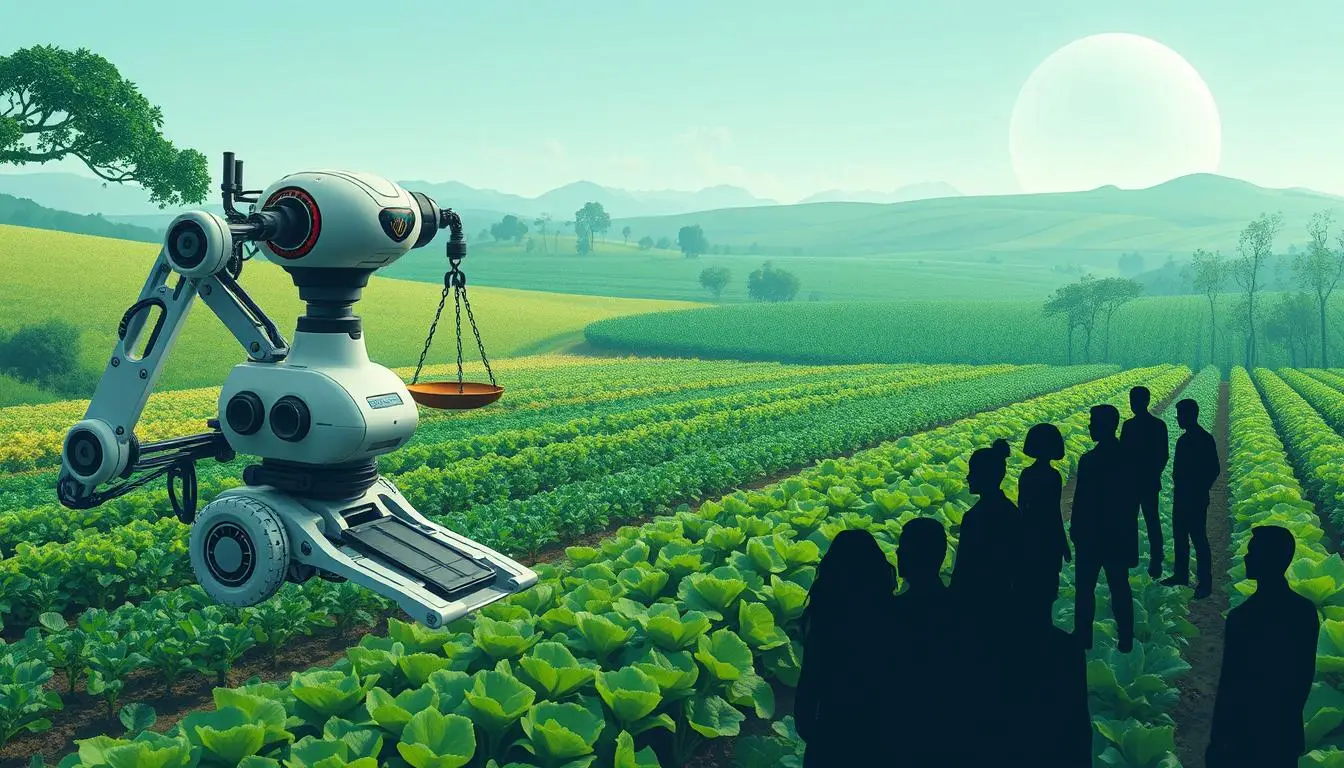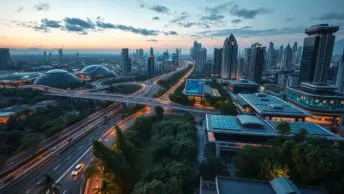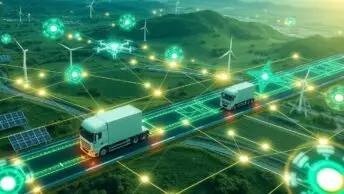How can we grow stronger in a world needing more resources, as our population soars? The answer lies with AgriTech, which shines as more than a tool. It’s spearheading AI in Agriculture to ensure we can feed our future. The future
To feed an expected 9.3 billion people by 2050, we need 60% more food1. This calls for a dramatic change in farming. By integrating AI in Agriculture, a field set to grow from $1.7 billion in 2023 to $4.7 billion by 20282, we find a path forward. Pests and soil issues threaten our crops, but AgriTech offers a beacon of hope amid these challenges.
Sustainable Farming is becoming real, thanks to AI. Systems like Trapview increase crop yields by 5% using AI for pest control1. CropX’s innovations cut water waste by 57%, moving away from old irrigation methods1. And robots like the LaserWeeder from Carbon Robotics can dramatically lower weed control costs by up to 80%1. This marks the start of an era in farming that’s smarter and full of promise.
The Growing Necessity of AI in Agriculture
As we look towards 2050, with a global population expected to hit 9.3 billion, agriculture faces a big challenge. It must boost food production significantly. Artificial Intelligence (AI) is key in tackling these issues, enhancing Global Food Security by enabling Precision Farming and effective Crop Monitoring. AI is revolutionising farming, making it more efficient and sustainable3.
Feeding a Burgeoning Global Population
AI plays a crucial role in upscaling food production without harming the environment. It allows for the precise use of fertilisers and pesticides. This approach leads to healthier crops and reduces costs3. AI-powered drones and satellites also improve Crop Monitoring. They identify early signs of stress, disease, or pests, thus protecting harvests3.
AI Market Growth Projections in Agriculture
Challenges in Traditional Farming
Traditional farming is under pressure from limited land and ongoing labour shortages, along with environmental challenges. For instance, pests consume around 40% of global agricultural output. Moreover, one-third of the planet’s soils are degrading3. AI helps overcome these obstacles by enabling the use of self-driving machinery. This reduces the need for labour and increases farming precision and efficiency3.
The Revolution of Smart Farms
Smart Farming is starting a new chapter in farming efficiency. It mixes AI Sensors with Farm Automation tech to improve farms worldwide. This change isn’t only about getting better but changing how farms operate. This leads to more produce, less waste, and easier work5. The mix of IoT and AI means farms can be watched and managed in real time. This makes farming sustainable and based on solid data5.
AI in Agriculture: A Multifaceted Approach
AI affects many farming areas, from big-picture crop checks to detailed soil care. Using AI for real-time info lets farmers predict crops well. It ensures farming is good for both the economy and the planet9.
Precision Farming: Enhancing Crop Production
AI boosts precision farming, making the use of resources and crop care better. Data from drones and satellites help with smart decisions for better crops. AI-driven crop monitoring in Japan uses 5G to improve farming and manage resources wisely8. AI also aids in creating tough crops fast, which helps food security across the world8.
Sustainable Farming: AI's Role in Conservation
In sustainable farming, AI makes sure farming is less wasteful and more efficient. Drones help with pollinating crops and keeping plants healthy. They also ensure quick action when needed. AI tech in irrigation shows its part in saving water, key for sustainable farming10. Using AI with satellite info, GeoAI watches crop conditions. This helps fight food shortages caused by climate change8.
AI’s varied roles in agriculture are crucial for boosting productivity and saving nature. As AI tech grows, it will make farming even more sustainable, efficient, and fruitful.
Agricultural Drones: Eyes in the Sky
Agricultural drones, or ‘eyes in the sky,’ are changing modern farming. They help with precision farming and crop check-ups, making farming more efficient and eco-friendly. With advanced imaging, these drones let farmers keep an eye on big, hard-to-reach fields, checking crop health and soil.
The market for agricultural drones is quickly growing, expected to hit billions soon11. This increase shows how vital drones are for precision farming. They help with tasks like fertilising and monitoring crops closely. In some places, drones help produce one in three bowls of rice by spraying pesticides11. In the US, they help manage crops like grapes, spotting areas that need more water or better soil11.
Drones don’t just watch; they also help with things like pollination in orchards. This can increase pollination rates by 25% to 65%, though this is still being checked11. Their use brings new ways to improve farming and food production worldwide.
The future looks bright, too. For example, the Asia Pacific drone market is expected to grow over 300%, reaching $2.9 billion AUD by 2028, up from $647 million in 202012. The global market for these drones could reach $8.4 billion AUD by then12. This growth is driven by the good return on investment for farmers, like saving $12 USD per acre for corn in the US12.
New trends like automated drones for seeding and data collection show the technology’s potential growth in farming12. As these technologies develop, they promise to make traditional farming more effective, sustainable, and productive.
The Impact of Smart Irrigation on Resource Conservation
Smart irrigation is changing farming by focusing on saving resources and using tech for automation. It makes water use on farms better and supports keeping the environment safe. Also, with the world needing more fresh water than available, finding smart ways to use water is critical13.
Efficiency and Water Sustainability
Automated Systems and AI Predictive Analytics
AI adds a forward-thinking layer to smart irrigation. With sensors, it gathers important data and spots problems, making water use more efficient14. AI can predict water needs based on the weather and soil moisture13. This makes every irrigation move based on solid data, improving yields and saving water.
Yield Prediction and Crop Monitoring Through AI
By 2050, the world’s population will grow a lot. This means more challenges for farming, especially because we won’t have much more land to farm on15. Yield prediction and looking after crops carefully is now vital. AI helps by making sense of huge amounts of data to guide farmers on how to get the best from their land15. This smart technology improves how resources like water and soil are used. It also makes sure crops grow well by tailoring farming practices to meet the land’s specific needs1516.
Farmers use AI to find and stop pests and diseases. This protects the crops and makes sure there’s plenty to harvest17. AI also makes watering crops smarter. It can cut water use by up to 40% in some places without reducing the amount of crops grown1716. Also, thanks to drones, farmers get a good look at their crops often. This means they can make smart choices to keep their farms running well17.
AI’s role in precision farming is getting better all the time. It predicts crop sizes more accurately than before15. GPS and IoT devices work with these AI systems. This means using resources like food and water for the crops gets even smarter. It also means farming has less impact on the planet16.
Even with these improvements, it’s not always easy for farming to use AI. Problems include getting hold of data, having the right internet setup, and the high cost of the tech15. But, by sharing data more and working together, farming is becoming more welcoming to these new methods15. The future of farming is exciting. With smart use of AI for predicting crop sizes and looking after crops, farming will be more about keeping our planet healthy and producing more food16.
Soil Analysis and Health Monitoring: The AI Edge
In the world of advanced farming, analysing soil has become key to keep farming sustainable and productive. Thanks to AI sensors, we can now improve soil management like never before.
From Data Collection to Actionable Insights
Shifting from hand-drawn soil maps to AI over the last 20 years has made soil analysis both faster and more precise18. The AI4SoilHealth project uses AI to map Europe’s soil health, looking at things like carbon and clay19. This lets farmers make smart choices to increase crop yield and protect the environment.
The Integration of IoT in Soil Management
IoT devices are crucial for gathering detailed soil data that AI systems examine to keep soil healthy. IoT connects all in real time, enabling quick actions like tweaking irrigation or fertilisers based on soil needs1820. Such precision farming helps maintain the best conditions for crops, leading to sustainable and more productive agriculture.
AI sensors not only improve soil management but also help meet future rules like the Soil Monitoring and Resilience law, expected in 202918. AI is changing farming, making it better prepared for climate shifts and upcoming challenges.
Farm Automation: Robotics in Harvesting and Weeding
Autonomous farming might become worth over $95 billion by 202722. This shows how tech is becoming key in farming.
With global food needs rising, we need to produce 56% more by 205022. Robots help meet this growing demand.
The market for weeding robots is set to grow massively23. Though it’s worth about $20 million now, it could be ten times bigger soon23. This is due to a lack of workers and a higher need for sustainable farming. But, the high costs of robots are a problem for smaller farms23. We need cheaper solutions for everyone23.
Robots are changing farming in a big way. They’re not just improving yields and efficiency. They’re also modernising how we farm. This fits with the goal of smart farming.
AI Sensors: The Technological Touchpoints of Agriculture
AI sensors are changing the game in farming, marking a new chapter of growth and green practices. These tools gather up-to-the-minute data, key for watching over things like soil wetness and plant well-being. This steady flow of info helps with exact farming, letting farmers take quick, smart steps to up their game and save resources.
The use of AI sensors in farming is a big leap forward. It’s needed to keep up with rising food needs. By 2050, we’ll have 9.8 billion mouths to feed, so farms must up their game24. Precise farming with AI sensors doesn’t just raise crop amounts. It also cuts down waste and makes the most of everything we use25.
Real-Time Data Collection
Collecting data right away is key in exact farming. AI sensors give farmers fast updates about their lands. This is vital for quick changes to farming ways. It helps plants grow well and lessens the risk of crops not doing well.
AI-enhanced Decision Making
AI helps farmers react faster to shifts in weather. For example, news on sudden weather shifts can lead to quick fixes, like changing water amounts or crop feed, to avoid harm. This makes farm decisions quicker, based on more facts, and better. It also boosts strategies in digital marketing.
Addressing Ethical Concerns and Employment in AgriTech
Integrating AI into farming helps improve output and sustainability but brings up ethical issues and job challenges. These need careful attention and smart policy-making. The predicted growth of AI in farming from $1.1 billion in 2019 to more than $3.8 billion by 202426 shows AI’s big impact in this area.
AI advancements like drones and robots can greatly cut down on chemicals, saving up to 90% on pesticides and lessening environmental damage26. But, they also introduce questions about jobs. There’s worry about workers losing their jobs to machines and the urgent need for farmers to learn new skills. Digital farming’s ethical rules aim to make the tech fair, transparent, and accountable to everyone26.
People care a lot about where their food comes from and how it’s made. This affects what they buy. It shows the link between trust in farmers and the need for sustainable farming27. Using AI needs to be not just efficient but also ethically right, respecting both those who make and buy food.
As AI tech gets better, we must also improve ethical rules. The release of voluntary guidelines and laws like the EU AI Act are key to building trust in AgriTech27. These steps help connect ethical ideas in AI to actual farming practices.

For AgriTech to really help everyone, especially those in remote areas, we must include local people in the conversation. Making sure we handle ethical issues in AgriTech well and update farming jobs for new tech is crucial for a sustainable farming future.
Conclusion
The engagement of AI Innovations in farming marks a major leap towards sustainable agriculture. It’s a sign of hope for the future of farming. With the world expecting nearly 10 billion people by 2050, food demand will rise by 70%2829. AI is seen as a key player in increasing food output while saving precious resources. Studies, over 20 of them, have shown an interest in AI in farming, with scholarly references tripling in just three years28. This shows that the academic world recognises AI’s importance in the future of agriculture.
This tech revolution is transforming how we farm, predict yields, and automate farms. It’s happening in countries like the Netherlands and India28. They are leading in research and use of this tech. For instance, robots from Blue River Technology are changing weed control by lowering costs and chemical usage30. In India, Jivabhumi uses blockchain for a ‘Smart’ Agricultural Marketplace to improve the supply chain30. This shows AI’s powerful impact on farming.
As we blend human skills with AI’s efficiency, ethical considerations are crucial. This ensures AI’s benefits reach everyone. Our goal is an agricultural system that is sustainable, efficient, and abundant. AI is leading the way to smarter, more considerate farming that helps both people and the planet.
FAQ
How is AI transforming agriculture?
AI is changing farming by making crop growing and care better with smart farming. It uses data, algorithms, and tech to boost farming efficiency. AI cuts down waste, making farming more sustainable.
What are some examples of AI technologies used in agriculture?
AI tools in farming include drones for checking crops, smart systems for water use, sensors for gathering data, and robots for picking and weeding crops.
Can AI in agriculture contribute to global food security?
Definitely, AI helps secure food globally. It does this by improving how we use resources and grow more food. This is key for supporting the world’s increasing population.
What is the projected market growth for AI in agriculture?
The market for AI in farming is set to soar, from
FAQ
How is AI transforming agriculture?
AI is changing farming by making crop growing and care better with smart farming. It uses data, algorithms, and tech to boost farming efficiency. AI cuts down waste, making farming more sustainable.
What are some examples of AI technologies used in agriculture?
AI tools in farming include drones for checking crops, smart systems for water use, sensors for gathering data, and robots for picking and weeding crops.
Can AI in agriculture contribute to global food security?
Definitely, AI helps secure food globally. It does this by improving how we use resources and grow more food. This is key for supporting the world’s increasing population.
What is the projected market growth for AI in agriculture?
The market for AI in farming is set to soar, from $1.7 billion in 2023 to $4.7 billion by 2028. This mirrors the growing need for smarter farming solutions.
How does smart farming impact traditional farming practices?
Smart farming changes traditional ways by introducing machines, cutting down on physical work, and using precise data for better decisions. It leads to farming that’s more fruitful and sustainable.
What are the sustainability benefits of AI-driven agriculture?
AI in farming makes using resources like water and fertiliser more precise. This helps protect nature while also boosting how much food we can grow.
How do agricultural drones assist farmers?
Drones help farmers by offering views from above. This helps in understanding crops better, predicting yields, and checking the soil. All this info helps farmers make smarter choices.
Why is water sustainability important in agriculture, and how does AI contribute?
Keeping water use sustainable is vital in farming to nurture crops right. AI helps by making sure water is used efficiently, cutting down waste.
How does yield prediction and crop monitoring through AI benefits farmers?
By predicting yields and monitoring crops, AI gives farmers a head’s up on how their crops are doing. It allows for better planning and quick actions to ensure a good harvest.
Are AI sensors important in modern agriculture, and if so, why?
AI sensors are crucial as they gather essential data on soil, crop health, and the environment in real-time. This lets farmers track and tweak how they farm for the best outcomes.
What role does AI play in farm automation, especially in terms of labour?
AI is key in automating farming by doing jobs like picking, weeding, and planting efficiently. This helps with worker shortages and lowers the hard work needed in farming.
How is the agriculture sector addressing ethical concerns regarding AI?
The farming sector is tackling AI ethics by putting in place rules and privacy measures. It’s also working to make sure tech is fairly available, balancing AI’s perks with its impacts on farm life.
How does smart farming impact traditional farming practices?
Smart farming changes traditional ways by introducing machines, cutting down on physical work, and using precise data for better decisions. It leads to farming that’s more fruitful and sustainable.
What are the sustainability benefits of AI-driven agriculture?
AI in farming makes using resources like water and fertiliser more precise. This helps protect nature while also boosting how much food we can grow.
How do agricultural drones assist farmers?
Drones help farmers by offering views from above. This helps in understanding crops better, predicting yields, and checking the soil. All this info helps farmers make smarter choices.
Why is water sustainability important in agriculture, and how does AI contribute?
Keeping water use sustainable is vital in farming to nurture crops right. AI helps by making sure water is used efficiently, cutting down waste.
How does yield prediction and crop monitoring through AI benefits farmers?
By predicting yields and monitoring crops, AI gives farmers a head’s up on how their crops are doing. It allows for better planning and quick actions to ensure a good harvest.
Are AI sensors important in modern agriculture, and if so, why?
AI sensors are crucial as they gather essential data on soil, crop health, and the environment in real-time. This lets farmers track and tweak how they farm for the best outcomes.
What role does AI play in farm automation, especially in terms of labour?
AI is key in automating farming by doing jobs like picking, weeding, and planting efficiently. This helps with worker shortages and lowers the hard work needed in farming.
How is the agriculture sector addressing ethical concerns regarding AI?
The farming sector is tackling AI ethics by putting in place rules and privacy measures. It’s also working to make sure tech is fairly available, balancing AI’s perks with its impacts on farm life.
Source Links
- The Future Of Farming: AI Innovations That Are Transforming Agriculture – https://www.forbes.com/sites/ganeskesari/2024/03/31/the-future-of-farming-ai-innovations-that-are-transforming-agriculture/
- AI in Agriculture — The Future of Farming – https://intellias.com/artificial-intelligence-in-agriculture/
- The Use of Ai (Artificial Intelligence) in Agriculture & Farming – https://www.agrirs.co.uk/blog/2024/02/the-use-of-ai-artificial-intelligence-in-agriculture-and-farming
- AI taking root in growing number of agriculture programs – https://www.insidehighered.com/news/tech-innovation/artificial-intelligence/2024/07/10/ai-taking-root-growing-number-agriculture
- How Smart Farming is Revolutionising Agriculture with IoT and AI – https://livefarmer.co.uk/how-smart-farming-is-revolutionising-agriculture-with-iot-and-ai/
- Transforming the Future of Farming – Strategic Allies – https://strategicallies.co.uk/article/the-digital-agriculture-revolution-transforming-the-future-of-farming/
- A silicon revolution for sustainable farming – https://blog.policy.manchester.ac.uk/posts/2024/02/a-silicon-revolution-for-sustainable-farming/
- Council Post: AI Applications In Farming: How Technology Can Help Solve Hunger – https://www.forbes.com/councils/forbestechcouncil/2024/07/25/ai-applications-in-farming-how-technology-can-help-solve-hunger/
- Harnessing Artificial Intelligence for Sustainable Agricultural Development in Africa: Opportunities, Challenges, and Impact – https://arxiv.org/html/2401.06171v1
- 7 Applications of AI in Agriculture | 2024 Updated | BasicAI’s Blog – https://www.basic.ai/blog-post/7-applications-of-ai-in-agriculture
- Eyes in the sky: 5 ways drones will change agriculture – https://knowablemagazine.org/content/article/technology/2018/eyes-sky-5-ways-drones-will-change-agriculture
- AgTech – https://www.daf.qld.gov.au/news-media/campaigns/agtech/action/future/drones
- Transforming Agricultural Water Management with AI: Optimizing Use and Enhancing Sustainability – https://medium.com/mark-and-focus/transforming-agricultural-water-management-with-ai-optimizing-use-and-enhancing-sustainability-c3f19c8406cc
- An overview of smart irrigation systems using IoT – https://openaccess.city.ac.uk/28838/1/1-s2.0-S2772427122000791-main.pdf
- AI in Agriculture – How Crop Monitoring and Precision Farming are Changing the Industry? – Data Science Society – https://www.datasciencesociety.net/ai-in-agriculture-how-crop-monitoring-and-precision-farming-are-changing-the-industry/
- AI In Agriculture: Crop Optimization and Yield Prediction – https://medium.com/@atliq/ai-in-agriculture-crop-optimization-and-yield-prediction-3740016392b5
- AI in Agriculture: Crop Monitoring and Precision Farming – https://medium.com/@jam.canda/ai-in-agriculture-crop-monitoring-and-precision-farming-016f79c11938
- Revolutionizing agriculture: Unleashing the potential of AI and big data in soil health monitoring – https://www.openaccessgovernment.org/article/revolutionizing-agriculture-unleashing-the-potential-of-ai-and-big-data-in-soil-health-monitoring/171706/
- AI 4 SOIL HEALTH – https://www.soilassociation.org/farmers-growers/our-farming-projects/ai-4-soil-health/
- Enhanced Soil Monitoring Using AI Insights – https://saiwa.ai/blog/soil-monitoring-using-ai/
- 15 Agricultural Robots and Farm Robots You Should Know | Built In – https://builtin.com/robotics/farming-agricultural-robots
- Field to Farm: How Robots in Agriculture Revolutionize Farming | AgriTechTomorrow – https://www.agritechtomorrow.com/article/2024/06/field-to-farm-how-robots-in-agriculture-revolutionize-farming/15585/
- Weeding robots: redefining sustainability in agriculture – https://howtorobot.com/expert-insight/weeding-robots-redefining-sustainability-agriculture
- 20 AI and Tech for Good Opportunities in Food & Agriculture – https://medium.com/@savinavds/20-ai-and-tech-for-good-opportunities-in-food-agriculture-768f7eaaccc6
- Unleashing the value of artificial intelligence in the agri-food sector: where are we? – https://www.emerald.com/insight/content/doi/10.1108/BFJ-11-2022-1014/full/html
- Recommendations for ethical and responsible use of artificial intelligence in digital agriculture – https://www.ncbi.nlm.nih.gov/pmc/articles/PMC9372537/
- Who is responsible for ‘responsible AI’?: Navigating challenges to build trust in AI agriculture and food system technology – Precision Agriculture – https://link.springer.com/article/10.1007/s11119-023-10063-3
- Artificial Intelligence in Agriculture: Benefits, Challenges, and Trends – https://www.mdpi.com/2076-3417/13/13/7405
- Leveraging artificial intelligence in agriculture: transforming the future of farming | illuminem – https://illuminem.com/illuminemvoices/leveraging-artificial-intelligence-in-agriculture-transforming-the-future-of-farming
- vikaspedia Domains – https://vikaspedia.in/agriculture/ict-applications-in-agriculture/artificial-intelligence-in-agriculture






